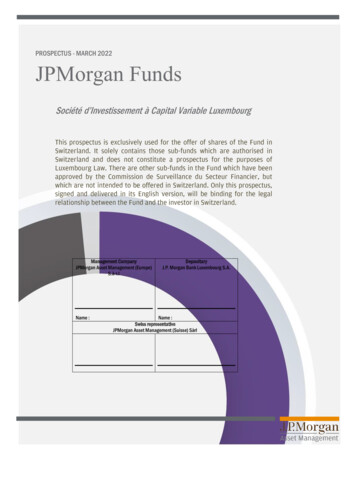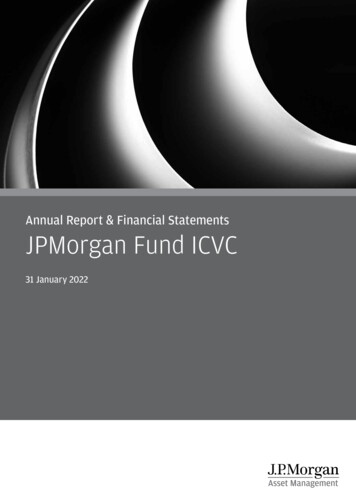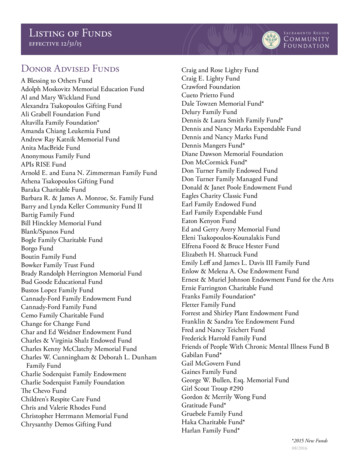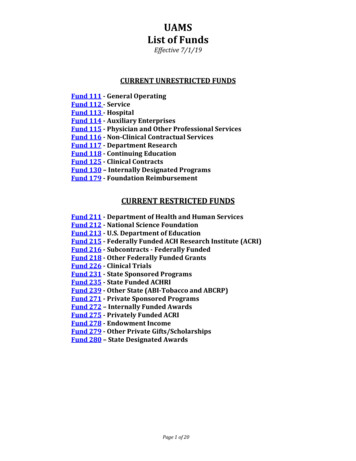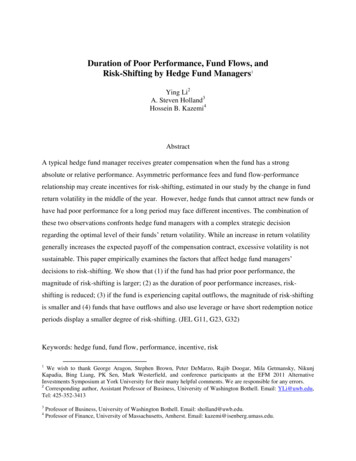
Transcription
Duration of Poor Performance, Fund Flows, andRisk-Shifting by Hedge Fund Managers1Ying Li2A. Steven Holland3Hossein B. Kazemi4AbstractA typical hedge fund manager receives greater compensation when the fund has a strongabsolute or relative performance. Asymmetric performance fees and fund flow-performancerelationship may create incentives for risk-shifting, estimated in our study by the change in fundreturn volatility in the middle of the year. However, hedge funds that cannot attract new funds orhave had poor performance for a long period may face different incentives. The combination ofthese two observations confronts hedge fund managers with a complex strategic decisionregarding the optimal level of their funds’ return volatility. While an increase in return volatilitygenerally increases the expected payoff of the compensation contract, excessive volatility is notsustainable. This paper empirically examines the factors that affect hedge fund managers’decisions to risk-shifting. We show that (1) if the fund has had prior poor performance, themagnitude of risk-shifting is larger; (2) as the duration of poor performance increases, riskshifting is reduced; (3) if the fund is experiencing capital outflows, the magnitude of risk-shiftingis smaller and (4) funds that have outflows and also use leverage or have short redemption noticeperiods display a smaller degree of risk-shifting. (JEL G11, G23, G32)Keywords: hedge fund, fund flow, performance, incentive, risk1We wish to thank George Aragon, Stephen Brown, Peter DeMarzo, Rajib Doogar, Mila Getmansky, NikunjKapadia, Bing Liang, PK Sen, Mark Westerfield, and conference participants at the EFM 2011 AlternativeInvestments Symposium at York University for their many helpful comments. We are responsible for any errors.2Corresponding author, Assistant Professor of Business, University of Washington Bothell. Email: YLi@uwb.edu,Tel: 425-352-341334Professor of Business, University of Washington Bothell. Email: sholland@uwb.edu.Professor of Finance, University of Massachusetts, Amherst. Email: kazemi@isenberg.umass.edu.
1. IntroductionHedge fund managers receive payoffs that are convex functions of the fund’sperformance, measured in both absolute and relative terms. On one hand, a typical managerearns 20% performance fee (Liang, 2000), which is based on the fund’s absolute performance,and is usually not subject to a claw-back policy. On the other hand, a convex fund flowperformance relation has been observed in the hedge fund industry (Agarwal et al., 2002), whichmeans fund flows respond more to a high ranking of relative performance than they do to a lowranking of relative performance. Since both performance fee and relative performance rankingare usually assessed annually at the end of a calendar year, the payoff structure, which is similarto that of a call option, may lead the managers to engage in mid-year risk-shifting, i.e., a midyear change of return volatility (Carpenter, 2000; Aragon and Nanda, 2012).While it is generally believed that convex incentive structures lead to risk-shifting, thequestions of why and under what conditions risk-shifting occurs remain unanswered (Ross,2004). Previous studies provide evidence supporting the presence of risk-shifting due to theimplicit incentive from the convex flow-performance relation, also known as the “tournamentincentive” (Brown et al., 1996). However, there is mixed evidence on how the explicit incentive,which is based on the convex compensation contract, influences risk-shifting (Brown et al.,2001; Aragon and Nanda, 2012). Clearly, the impact of the explicit incentive on the risk-shiftingbehavior of managers is of general interest because stock options are used extensively inexecutive compensation contracts. While executives have the power to influence theircompensation contracts, hedge funds usually set up their compensation structure at inceptionwith little alteration going forward (Agarwal et al., 2009). Hedge funds, therefore, offer alaboratory to test the relation between convex payoff and risk-taking behavior with less concernabout endogeneity.This paper attempts to address the gap in the literature by focusing on the joint impact ofhedge fund managers’ expected payoffs from their compensation contracts, direction of fundflows into or from their funds, and past performance on their risk-shifting decisions. Sincemanagers hold a portfolio of investor-specific1 performance fee options, we show that not only1Though theoretical models of optimal risk-taking by fund managers refer to a unique fund-level HWM (Carpenter,2000; Panageas and Westfield, 2009), in practice, in order to avoid the free rider problem, hedge funds issue newshare classes as new investors contribute capital to the fund. This means, the HWM is defined at the investor level
the most recent performance, but cumulative past performance matters for their risk-shiftingdecisions. Risk-shifting is not a strategy that can repeatedly be used, as a fund’s return volatilitywill become exceedingly unattractive. We show that the duration of a fund’s poor performance, afactor that, to the best of our knowledge, has not been explored in prior research, influences therisk-shifting decision of managers. Furthermore, we show that two important fundcharacteristics, the length of redemption notice period required by a fund and, especially, the useof leverage by the fund manager, interact with fund flows to impact a manager’s risk-shiftingpolicy. Taking the history of a fund’s performance into account also helps reconcile thepreviously reported mixed evidence regarding the relation between the moneyness of theperformance fee option and risk-shifting policies of fund managers.Our main source of data is the Morningstar/CISDM database over the sample period ofJanuary 1994 through December 2012. Similar to Aragon and Nanda (2012), we construct aproxy for the high-water mark (HWM) of a hedge fund by tracking its net asset value (NAV)over a three-year window using reported net-of-fees returns. Our empirical framework to identifythe conditions that may influence a hedge fund manager’s risk-shifting decision includes twovariables that are measured after the fund achieves its HWM: performance and fund flow. Forperformance, we also consider the duration of underperformance, to assess the long-termfeasibility of risk-shifting.We use the performance and fund flow estimates along with the HWM proxy to identifythe “state” that describes (1) the moneyness of a hedge fund manager’s compensation optionportfolio and (2) the fund flow condition. Then, we focus on the interactions between (1) thestate variables and the first half-year performance and (2) the state variables and fundcharacteristics in a regression setting to investigate hedge funds’ state-dependent risk-shiftingbehavior.We document several new findings. First, a hedge fund manager’s risk-shifting is morepronounced when the fund is in a state that its performance fee option is partly out-of-the-money.The magnitude of risk-shifting for a fund in such a state is more than double that of a fund in thestate where the performance fee option is at-the-money. Most hedge funds have performed wellduring our sample period with about 75% of managers having at-the-money performance feeand not at the fund level. The incentive to change the fund’s volatility, therefore, is based on the sensitivity of thevalue of a portfolio of call options with different strike prices (i.e., HWMs) to the changes in the volatility of thefund’s portfolio.
option. We find less risk-shifting among these managers, which may explain the mixed evidencereported by Brown et al. (2001) and Aragon and Nanda (2012). Second, risk-shifting ceases if afund’s NAV is below its HWM proxy for an extended period. We find that a fund reacts to poorperformance by increasing its return volatility in the short-run, but does not engage in riskshifting after being underwater for more than one year. Third, when facing outflows, a fund thatemploys leverage usage or imposes short redemption notice on its investors engages in a smallermagnitude of risk-shifting.Besides performance, fund flows, leverage, and redemption periods, a number of othermanager characteristics such as the manager’s physical location, education, and risk-aversioncould influence a fund’s risk-shifting incentives. A manager is typically part of the ownershipstructure of a hedge fund, and, therefore, remains with the fund throughout its life (Liang, 2000).Consequently, regressions with fund fixed effects greatly alleviate the concern of biasedestimates due to the presence of omitted time-invariant variables.2 Our empirical findings arerobust to using fund fixed effects regressions, and are robust to variations in our methodology,including varying the definitions of poor performance and fund flows. The findings also appearto be robust to the impact of potential biases, as our results are similar when we use a sample thatis less subject to backfill bias (the “no backfill bias” sample) and the full sample.Our study is related to a large literature on hedge funds’ managerial risk-taking incentivesand behavior conditional on fund characteristics. A number of empirical studies have examinedhedge fund managers’ risk-taking by investigating the impacts of survival and career concerns(Fung and Hsieh, 1997; Brown et al., 2001; Aragon and Nanda, 2012), presence of high-watermark provisions and managerial stakes (Aragon and Nanda, 2012), usage of derivatives (Chen,2013), and past performance history (Aragon and Nanda, 2012; Ray, 2012). Past studies alsodocument a convex relationship between fund flows and performance for mutual funds(Chevalier and Ellison, 1997; Sirri and Tufano, 1998), and for hedge funds (Agarwal et al.,2002), how fund flows are related to risk taking decisions in the mutual fund industry (Basak etal., 2007; Hu et al., 2011) and how a less convex flow-performance relation leads to less riskshifting in the pension fund industry (Del Guercio and Tkac, 2002). Additional studies examinethe interaction of leverage policy and risk taking strategies (Brown et al., 2001; Ang et al., 2011),2Firm fixed effects regression models are widely used in the corporate finance literature to reduce endogeneityconcerns due to time-invariant omitted variables. For example, Adams and Ferreira (2009), Oikonomou, Brooks,and Pavelin (2012).
and explore the interaction between fund flows, performance, and managerial incentive in thehedge fund industry (Agarwal et al., 2002 & 2009). The importance of liquidity provisions inaffecting hedge fund risk-return profiles is examined in Getmansky et al. (2004) and Aragon(2007). Li and Kazemi (2007) and Cumming and Dai (2010) investigate the conditionalproperties of hedge funds’ return distributions.We add to this vast literature by showing that hedge fund managers use risk-shifting as atransient strategy to maximize payoffs. We also show that fund outflows play an important rolein hedge fund managers’ risk-shifting decisions. Because we control for fund-level fixed effects,our results are less prone to endogeneity concerns due to time-invariant non-observable missingvariables that may influence a fund’s risk-shifting decision.The paper’s structure is as follows. Section 2 presents the methodology, testablehypotheses, and the data, Section 3 discusses the research design and results, Section 4 presentstests for robustness, and Section 5 concludes.2. Methodology, hypotheses and data2.1 MethodologyFollowing Aragon and Nanda (2012), our research variable is the change in the returnvolatility of each hedge fund in our sample during the second half of the year compared to thevolatility in the first-half year. From the limited data disclosed by hedge funds, we use a rollingthree-year window to estimate the maximum HWM of each fund’s current investments and toobtain a history of its fund flows. With the help of the HWM proxy, we estimate two states foreach hedge fund: (1) Past performance-related state, which we refer to as the Moneyness of itsperformance fee option and (2) fund Flow. We use these estimates to examine the responses ofhedge fund managers to poor performance in the first half of the fourth year. The maximumvalue of each fund’s NAV during the three-year window is compared to the fund’s NAV at thebeginning of the fourth year (evaluation year) as the measure of moneyness of the performancefee option:Moneynessi ,t NAVi ,tHWM i ,t(1)In the above definition of Moneyness, 𝑁𝐴𝑉𝑖,𝑡 is the net asset value of a share of hedgefund 𝑖 as of the end of the three-year (36-month) window (the beginning of the evaluation year),
and 𝐻𝑊𝑀𝑖,𝑡 max (𝑁𝐴𝑉𝑖,𝑡 𝜏 ; 0 𝜏 36) is the maximum level of NAV over the three-yearwindow.If Moneyness is equal to one, the manager’s performance fee option for all assets undermanagement is at the money. If Moneyness is less than one, the manager’s performance feeoption is out-of-the-money for at least some of the assets under management. Clearly, ourestimate of the moneyness of the performance fee option is subject to errors. We check for therobustness of our results by changing the cutoff threshold of Moneyness in Section 4.It is important to note that Moneyness is a conditioning variable that refers to the status ofthe performance fee option at the beginning of the evaluation year.3 Furthermore, depending onthe timing of the investment, each share class will have its own specific HWM, and, therefore, itsspecific degree of moneyness. This means that the variable defined as Moneyness in Equation(1) should be interpreted as a proxy for the aggregated moneyness of all share classes of a givenfund at the beginning of the year. In addition, unless there are inflows, a fund that has negativeperformance during the first half of the year will not collect a performance fee unless it displayspositive performance during the second half of the year.We estimate the fund-level aggregate flow by comparing the actual assets undermanagement as of mid-evaluation year to the expected assets under management calculatedbased on the fund’s cumulative return since the time the HWM was achieved. The aggregatedfund-level flow over [𝑡𝐻𝑊𝑀 , 𝑡 6] is calculated following Sirri and Tufano (1998):Flowi ,tHWM ,t 6 AUM i ,t 6 1 ARi ,tHWM ,t 6 AUM i ,tHWMAUM i ,tHWM(2)Where t HWM is the time when the HWM was reached, t is the beginning of the evaluation year,𝐴𝑈𝑀𝑖,𝑡 6 is the amount of assets under management as of June 30 of the evaluation year, 𝐴𝑈𝑀𝑖,𝑡𝐻𝑊𝑀 is the amount of assets under management at the time when the HWM was reached,and 𝐴𝑅𝑖,𝑡𝐻𝑊𝑀 ,𝑡 6 is the accumulative return over the window [𝑡𝐻𝑊𝑀 , 𝑡 6].We define two dummy variables, M and F, to describe the state a fund is in depending onits moneyness and flow conditions. We set M equal to 1 if Moneyness 0.9 as of the beginningof the evaluation year, indicating that the fund has had meaningful negative returns after3The results do not change if Moneyness is measured mid-year. The results are available from the authors uponrequest.
reaching its HWM. We set F equal to 1 if Flow 0 , indicating that the fund has experiencedoutflows after reaching its HWM.42.2 HypothesesAs hedge fund managers react to convex payoffs, whether they are from the embeddedoption in their compensation contracts or the asymmetric flow-performance relation, our firsthypothesis is straightforward:Hypothesis 1: Fund volatility increases following poor performance in the first half of theyear.Hypothesis 2 relates a hedge fund manager’s risk-shifting to the state the fund may finditself in depending on Moneyness and Flow. If a large proportion of the manager’s performancefee option portfolio is out-of-the-money at the beginning of the year, the manager will need toincrease the volatility by a larger amount to obtain the same amount of benefits obtained by thefund if only a small portion of the performance fee option is out-of-the-money. Thus, themoneyness determines the magnitude of change in volatility needed to bring about a givenchange in the value of the performance fee option.We hypothesize that fund outflows affect how a fund weighs the cost of risk-shifting.5That is, if a fund has negative performance but no outflows, the manager may conclude thatinvestors still have a positive view of the fund, and, therefore, the costs associated with riskshifting are not significant. However, if a fund experiences outflows following poorperformance, costs associated with increased risk-shifting will be deemed significant, and themagnitude of risk-shifting by such a fund is likely to be small. This argument leads to oursecond hypothesis:Hypothesis 2: The increase in return volatility following poor performance in the firsthalf of the year is greater for a fund that has an out-of-the-money performance fee option andhas experienced no fund outflows.4We use dummy variables (M and F) instead of continuous variables for Moneyness and Flow to mitigate somemulticollinearity issue and to allow errors of margin since Moneyness and Flow are based on the estimated HWMproxy and therefore are not exact measures. We also conduct robustness checks for various M and F definitions inSection 4.5Fund flow has been used as a measure for investors’ sentiment. (For example, Jain and Wu, 2000; Barber, Odean,and Zheng, 2004; Frazzini and Lamont, 2008).
In addition, we explore the roles fund characteristics play in the dynamics of fund flows,the moneyness of the performance fee option, and the manager’s risk-shifting policy. Past studieshave examined how certain fund characteristics influence hedge fund managers’ risk-shiftingincentive and behavior. For example, using a theoretical model, Hodder and Jackwerth (2007)argue that managerial stake reduces the incentive for risk-shifting; Aragon and Nanda (2012)provide empirical evidence supporting this argument. We focus on two other characteristics thatare likely to stand out due to their close relationship with fund flows and risk: the redemptionnotice period and the use of leverage. Getmansky et al. (2011) and Aragon et al. (2014) showthat the flow-performance relationship turns concave from convex when the fund imposes sharerestrictions. Redemption notice period is a type of share restriction, and short redemption noticeperiods allow investors to react quickly to changes in the fund’s investment style, and, therefore,risk-shifting could lead to increased outflows.Hypothesis 3a: Conditional on fund outflows, the increase in return volatility is smallerfor hedge funds that have short redemption notice periods.Just as funds with short redemption notice periods could face increased cost associatedwith shifting risk, funds that use leverage may also find such a policy costly. In the absence ofany changes in a fund’s investment and leverage policy, return volatility of the fund willendogenously increase following a period of poor performance. On the other hand, when thefund experiences outflows, managers may be more wary of the cost of increasing volatility andrefrain from doing so. Furthermore, even if the manager wanted to increase volatility, lendersmay impose active constraints on risk-shifting policies of a fund (Brown et al., 2001). Bothscenarios would result in a smaller increase in volatility.Brown et al. (2001) find empirical evidence for non-passive leverage policy, Ang et al.(2011) show hedge funds are experts at managing their leverages compared to listed financialintermediaries, and Lan et al. (2013) suggest active leverage policy in a theoretical model; basedon these studies, we argue that levered funds will find it too costly to increase their returnvolatility if they have experienced fund outflows.Hypothesis 3b: Conditional on fund outflows, the increase in return volatility is smallerfor hedge funds that use leverage.
Our last hypothesis is about the impact of the duration of time that a fund’s portfolio ofperformance fee options has been partly out-of-the-money on its risk-shifting decision. On onehand, if a fund has not collected performance fees for a long time, the fund may have attemptedrisk-shifting before or the fund’s performance fee option is deeply out-of-the-money so that riskshifting may no longer help. Thus, it may not react to poor first half-year performance. On theother hand, the manager of such a fund may consider closing the fund and walking away from it.Such a manager may decide to increase the volatility as a last attempt to collect performance feesand extend the life of the fund (see Hodder and Jackwerth, 2007; Drechsler, 2014). Thus, thefund may further increase its return volatility after poor first-half year performance.Hypothesis 4: Duration of poor performance affects the risk-shifting behavior of hedgefund managers.2.3 Hedge fund sampleWe use the Morningstar-CISDM Hedge Fund Database for this study.6 This databaseprovides information on performance and various characteristics of thousands of hedge funds,funds of hedge funds, and CTAs.7 For each fund, we observe monthly net-of-fees returns, NAV,major trading strategy claimed by the fund, whether the fund is listed on an exchange, and theregulatory agency for the fund.8 For most funds, we are also able to obtain information on theirinitiation months; assets under management (AUM); currency of AUM; performance fee rate;management fee rate; whether they use leverage; and liquidity constraints they impose includinglockup period, redemption notice period, and redemption frequency. Following Sirri and Tufano(1998), we use monthly AUM and returns to calculate aggregated fund flows occurring after afund has achieved its HWM. We do not have data on manager’s ownership share of the fund, orthe reasons for a fund to appear in the defunct database.We focus on US-dollar-denominated individual hedge funds and exclude funds of hedgefunds and CTAs.9 Each hedge fund is required to have 48 months of return history10 and6The Morningstar Hedge Fund Database is built on the CISDM database, which used to be Zurich Hedge FundUniverse, formerly known as the MAR database.7Funds of hedge funds are portfolios of individual hedge funds. CTAs are funds that specialize in futures trading.8We use net-of-fees returns for this study. We recognize that the HWM and fees are based on returns computedbefore all management fees and performance fees are subtracted, hence gross returns will be most appropriate to use.However, past research demonstrates little difference from using net-of-fee returns versus using gross returns.9The incentive to shift risk is less obvious for funds of hedge funds. For example, Agarwal et al.(2002) do not findfunds of hedge funds to exhibit strategic risk-taking behavior and attribute it to the inflexibility of the business.
information on characteristics, including fund size (AUM), and the strategy followed by themanager (style). We are aware that these requirements may introduce certain biases into oursample selection process. We perform robustness checks to understand the potential impact ofthese biases. After applying the above filters, we are left with 11934 individual observations forthe full sample and 8199 observations for the no backfill bias sample.11 123. Empirical results3.1 Summary statisticsWe examine monthly return data from January 1994 to December 2012 to evaluate hedgefunds’ risk-shifting behavior from 1997 to 2012. We include both live and defunct funds tominimize survivorship bias. To mitigate unwarranted noise from outliers, we also winsorize oursample at 1% and 99% for the following measures: fund’s return volatility in the first and secondhalf years, the moneyness of a fund’s performance fee option and fund flow.The summary statistics of our sample are reported in Table 1. There are 11934 individualobservations appearing in the database between January 1994 and December 2012 with thenumber increasing every year through 2007 steadily and declining thereafter. Panel A shows thatthe mean level of AUM at the beginning of each evaluation year increased from 131.83 millionin 1997 to 234.92 million in 2008 and then fell to 155.81 million in 2012. Panel B reportsthe number of fund-year observations for the eight styles (namely, Convertible Arbitrage, Debtrelated, Equity-related, Event Driven, Global Macro, Merger Arbitrage, Multi-strategy andVolatility) in our study. It shows that Equity-related is the most prominent style of funds in oursample, representing about 62% of both the full and no backfill samples.Panels C and D report the summary statistics of our dependent variable, independentvariables and control variables used in base case regressions for both no backfill bias and fullCTAs are a group of managers that trade on highly liquid futures and there is less variation in the liquidity provisionat CTAs. However, robustness checks show that our results are robust to including all funds of hedge funds. Theseadditional results are available upon request.10We relax this requirement in robustness tests and our results are qualitatively the same.11The Morningstar-CISDM Hedge Fund Database uses a dummy variable for high-water mark provision, where a“1” means the fund has a high-water-mark. About 88% of the hedge funds in our sample report that they have ahigh-water mark (10002 out of the full sample and 6851 out of the no backfill sample, some funds have missinginformation). We report results below by assuming all hedge funds with missing information have high-water markprovisions. The results from a sample that excludes funds with those funds with missing information on their highwater mark provisions are largely the same. The results are available upon request.12No backfill bias sample excludes returns that are “backfilled”, which occur prior to when the fund was added tothe database, to minimize the backfill bias as discussed in Fung and Hsieh (2000).
samples. Out of 8199 fund-year observations in the no backfill bias sample, 2020 have M 1,while 4502 have F 1, and 1520 funds have both M and F equal to 1, indicating that these fundshave had negative flows and performance decline of more than 10% since reaching HWM duringthe previous 36 months. Out of the 11934 fund-year observations in the full sample, 2809 havehad such negative return history (M 1), 6180 have had negative aggregate fund flows (F 1),2037 have had both M and F equal to 1. The summary statistics show that even though poorperformance is likely to result in fund outflows, the distinction between poor performance andoutflows is meaningful and necessary. While M and F are correlated, they capture separate fundcharacteristics.Finally, Panel E reports the distribution of funds with and without leverage usage andwith and without short redemption notice periods under different moneyness and flow conditionsfor both no backfill bias and full samples. As we can observe from Panel E, more fund-yearobservations are associated with leverage usage, and more fund-year observations are associatedwith short redemption notice periods. For example, for the no-backfill-bias sample, there are4403 and 5163 fund-year observations that report leverage usage and impose short redemptionperiods, respectively. There are 1338 and 3036 fund-year observations that do not use leverageand impose long short redemption periods, respectively.[Table 1 about here]We also report the correlation coefficients for our variables in Table 2. The Pearsoncorrelation coefficient for M and F is 0.23, suggesting that multicollinearity should not be amajor concern.[Table 2 about here]3.2 Regression analysisTo investigate the risk-shifting of hedge fund managers when they are in states definedby M and F, we use multivariate regression to estimate the following equation over the period of1997-2012, with a focus on the interaction terms 𝑀 𝑃𝑒𝑟𝑓, 𝐹 𝑃𝑒𝑟𝑓, 𝑇𝑖𝑚𝑒 𝑃𝑒𝑟𝑓, 𝐹 𝐿𝑒𝑣𝑒𝑟𝑎𝑔𝑒 and 𝐹 𝑆ℎ𝑜𝑟𝑡𝑁𝑜𝑡𝑖𝑐𝑒:
DifStd 1 M 2 Perf 3 M Perf 4 F 5 F Perf 6 TimeUnder 7 TimeUnder Perf 8 F Leverage 9 F ShortNotice 10 LagStd 11 AuCorr 12 SecondFlow FundCharacteristic M FundCharacteristic F FundCharacteristicjjj jjkjjj(3)jDummyk kwhere M 1 if Moneyness 0.9 and 0 otherwise,13 and F 1 if Flow 0 and 0 otherwise.The performance of a fund during the first half of the year, which is denoted by Perf, is acritical variable. We use three different measures of the variable Perf: (1) NegRet, a dummyvariable that equals one if the cumulative return over the first half of an evaluation year isnegative and zero otherwise, (2) LowAbsRetRank, a dummy that equals one if a fund’scumulative return over the first half-year is below the median of all funds and zero otherwise,and (3) LowRelRetRank, a dummy that equals one if the cumulative return over the first-half ofthe year is below the median of funds within a given style and zero otherwise. If funds engage inmid-year risk shifting, the coefficient on Perf will be positive as funds with poor first half-yearperformance increase volatility in the second half-year. We initially focus on NegRet to explorehow the explicit incentives arising from out-of-the-money compensation contracts affect hedgefund risk shifting.We consider the other two variables (LowAbsRetRank and LowRelRetRank)in additional tests in Section 4.The interaction terms M Perf and F Perf indicate how the magnitude of volatilitychange following poor first half-year performance reacts to changes in M and F, i.e., when thefund is in a certain M- and F- dependent state.TimeUnder, an abbreviation for time-underwater, is a continuous integer that rangesbetween 0 and 35 and is defined as 36 t HWM ,i ,t TimeUnderi ,t 0 if Moneynessi ,t 0.9(4)if Moneynessi ,t 0.9for fund i as of time t, the beginning of each evaluation year. TimeUnder is an estimate of thenumber of months that a fund’s NAV has been less than 0.9 of its
We document several new findings. First, a hedge fund manager's risk-shifting is more pronounced when the fund is in a state that its performance fee option is partly out-of-the-money. The magnitude of risk-shifting for a fund in such a state is more than double that of a fund in the state where the performance fee option is at-the-money.



